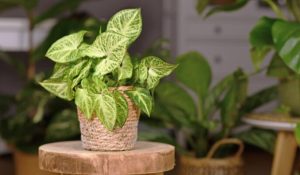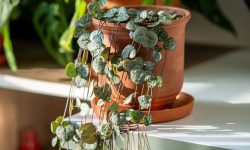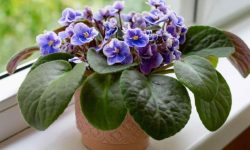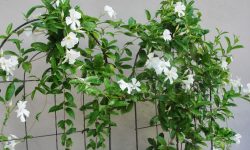Arrowhead plants are natural climbers and popular houseplants. These vines can be pruned to fit in the hanging baskets and flower pots. Besides that, arrowhead vines are unkillable due to their sturdy nature hidden behind their beautiful and delicate appearance.
Despite sounding impossible to kill them, you need to provide specific sets of growing conditions to foster healthy growth and well-being. Learning how to care for arrowhead plants is a no-brainer task for many houseplant enthusiasts.

Arrowhead Plant Care Overview
Scientific Name |
Syngonium podophyllum |
Common Names |
Arrowhead Vine |
Origin |
Mexico, South America |
Maximum Growth Height (Approx.) |
3-6ft tall |
Soil Requirement |
Well-draining potting mix |
Watering Need |
Ensure the potting soil is moist. Do not make the soil soggy. |
Temperature Range |
65-80°F during the day and above 60°F at night |
Humidity Level |
Maintain humidity above 40% |
Sunlight Requirement |
Bright indirect sunlight. Avoid bright direct sunlight since it will scorch the leaves. |
Fertilizer Application |
Feed the plant once with liquid fertilizer throughout fall, spring, and summer |
Propagation |
Stem cutting during the spring season |
Re-potting |
Re-pot the plant yearly due to its rapid growth and refresh the potting soil |
Pruning and Maintenance |
Remove the lower yellow leaves to direct energy to the growing parts. |
Arrowhead Plant Flowers |
White. The plant rarely blooms in summer. |
Pests and Diseases |
Pests: Spider mites, aphids, scales, and mealybugs. Diseases: Leaf spot disease and root rot. |
Toxicity |
Toxic to dogs and cats |
Growth Rate |
Fast growing |
USDA Zones |
10-12 |
How to Care for Arrowhead Plant
Caring for arrowhead vines may sound simple. But it requires a set of skills and knowledge to ensure healthy growth in the house. Below are some of the ways how to care for arrowhead plants in your house:
Soil Requirement
The soil plays a crucial role in the growth of arrowhead plants. Arrowhead plants thrive in well-draining soil that is rich in organic matter. Good soil allows for proper root development and nutrient absorption.
Poor soil quality can hinder the growth of arrowhead plants. Heavy or compacted soil restricts root development and causes waterlogging, leading to root rot. Inadequate drainage can also lead to nutrient deficiencies or toxicity, negatively impacting the plant’s overall health.
Use a well-draining soil mix consisting of equal parts peat moss, perlite, and potting soil. This mixture provides adequate moisture retention while allowing excess water to drain away. Avoid using heavy garden soil or clay-based soil, as they can cause waterlogging.
Watering Needs
Proper watering is essential for the growth and health of arrowhead plants. The watering regimen significantly impacts their growth in both positive and negative ways. Adequate water supply promotes healthy foliage, robust root development, and overall plant vitality.
When watered correctly, arrowhead plants flourish, displaying vibrant leaves and vigorous growth. Sufficient water prevents the plant from experiencing drought stress, which can lead to wilting, leaf drop, and stunted growth.
Overwatering can be detrimental to arrowhead plants. It can lead to root rot, fungal diseases, and the development of stagnant water conditions, promoting the growth of harmful bacteria. Excess moisture in the soil can suffocate the roots and hinder their ability to absorb oxygen.
Water arrowhead plants thoroughly when the top inch of the soil feels dry. Water until it flows out of the drainage holes, ensuring proper hydration. Allow the soil to dry out slightly between waterings to prevent waterlogged conditions. Use your finger to check the moisture level in the soil regularly.
Avoid leaving the plant sitting in a saucer of standing water, as it can lead to root rot. It’s better to underwater slightly than to overwater. Adjust the watering frequency based on the environmental conditions and the specific needs of your arrowhead plant.
Sunlight Requirement
Sunlight is a vital factor in the growth and well-being of arrowhead plants. It affects their growth in both positive and negative ways. Adequate sunlight exposure is crucial for the plant’s photosynthesis process, which provides energy for growth and development.
In optimal lighting conditions, arrowhead plants thrive, displaying vibrant foliage and compact growth. They require bright, indirect light for at least six hours a day to maintain their health and vibrant colors.
Insufficient light can negatively impact arrowhead plant growth. In low light conditions, the plant may stretch or become leggy as it reaches towards the available light source. The leaves may lose their vibrant coloration and become pale or dull.
To maintain healthy growth, place your arrowhead plant in a location that receives bright, indirect light. Avoid direct sunlight as it can scorch the leaves. East or west-facing windows are generally suitable for providing the right balance of light intensity.
Regularly rotate the plant to ensure even light distribution and balanced growth. If you notice signs of insufficient light, such as leggy growth or pale leaves, consider providing additional light sources.
Temperature Range
The temperature range plays a significant role in the growth and development of arrowhead plants. It influences their growth both positively and negatively. Arrowhead plants thrive in average room temperatures between 65°F and 75°F (18°C to 24°C).
Within the suitable temperature range, arrowhead plants exhibit vigorous growth and maintain their vibrant foliage. The warmer temperatures promote metabolic processes, aiding in nutrient absorption and overall plant health.
Extreme temperatures, whether too hot or too cold, can negatively impact arrowhead plant growth. Exposure to temperatures below 60°F (15°C) can cause leaf discoloration, slowed growth, and even cold damage. Temperatures above 85°F (29°C) can lead to heat stress and decreased vigor.
Keep your arrowhead plant in a location with stable temperatures within the recommended range. Avoid placing it near drafts, heating vents, or air conditioning units that can cause temperature fluctuations. Protect the plant from cold drafts during the winter months.
Provide adequate ventilation to prevent heat build-up around the plant, especially during hot summer months. If the temperature tends to fluctuate in your environment, consider moving the plant away from extreme temperature zones.
Humidity Level
The humidity level plays a crucial role in the growth of arrowhead plants. It affects their growth both positively and negatively. Arrowhead plants thrive in environments with moderate to high humidity levels, typically ranging from 50% to 70%.
In a suitable humidity range, arrowhead plants exhibit healthy growth with lush foliage and vibrant colors. Sufficient humidity promotes optimal transpiration, allowing the plant to absorb moisture and nutrients effectively.
Low humidity can lead to leaf browning, curling, and a decline in overall plant health. It also makes the plant more susceptible to pest infestations. Increase humidity levels around your arrowhead plant by using a humidifier or employing simple techniques.
Grouping plants together can create a microclimate with higher humidity. Placing a tray filled with water and pebbles beneath the plant pot helps increase moisture in the surrounding air through evaporation.
Regularly mist the foliage of the arrowhead plant with room-temperature water to provide additional moisture. Avoid misting excessively, as it can lead to fungal diseases. Monitor the humidity levels using a hygrometer and adjust the humidity-enhancing methods accordingly.
Fertilizer Application
Fertilizer application is important for promoting the growth and development of arrowhead plants. When used correctly, fertilizers provide essential nutrients that support plant growth and enhance overall health.
Fertilizer application on arrowhead plants will increase foliage growth, vibrant leaf coloration, and improved plant vigor. Fertilizers supply essential macronutrients (nitrogen, phosphorus, potassium) and micronutrients (iron, manganese, zinc) that may be lacking in the soil.
Improper or excessive fertilizer application can have negative consequences. Over-fertilization can cause salt build-up in the soil, leading to root burn, leaf discoloration, and even plant death. It can also disturb the balance of nutrients, resulting in nutrient deficiencies or toxicities.
Use a balanced water-soluble fertilizer formulated for houseplants. Fertilize arrowhead plants every two to four weeks during the growing season (spring and summer) and reduce or stop fertilization during the dormant period (fall and winter).
Before applying fertilizer, ensure the soil is adequately moist to prevent root damage. Water the plant thoroughly a day or two before fertilizing. Dilute the fertilizer in water according to the package instructions and apply it to the soil, avoiding direct contact with the leaves.
Regularly monitor the plant for any signs of nutrient deficiencies or excesses. Adjust the fertilizer application based on the plant’s response and specific needs. Remember to flush the soil occasionally by watering the plant with plain water to prevent salt build-up.
Propagation
Propagation is a method of multiplying arrowhead plants by taking cuttings from mature plants and encouraging them to develop into new plants.
Select a healthy stem with several leaves and make a clean cut just below a node. Remove the lower leaves to expose the nodes. Place the cutting in a jar or vase filled with water, ensuring that the nodes are submerged.
Over time, the cutting will develop roots from the nodes and can then be potted in well-draining soil. This allows for the growth of a new arrowhead plant that inherits the desirable traits of the parent plant.
Improper cutting techniques, unsanitary tools, or using weak or diseased plant material can lead to failed propagation attempts or the transfer of pests or diseases to new plants.
Regularly monitor the propagated cuttings for signs of root development and adjust the care as needed. Once the cuttings have developed a healthy root system, carefully transplant them into individual pots with well-draining soil.
Re-potting
Re-potting is an essential aspect of arrowhead plant care that can positively influence their growth and well-being. It provides an opportunity to refresh the soil, promote root growth, and accommodate the plant’s increasing size.
Re-potting also allows you to remove any compacted or depleted soil and inspect the roots for any signs of disease or pest infestation. But transplant shock, root damage, or inadequate aftercare can stress the plant and hinder its growth.
Re-pot your arrowhead plant when it becomes root-bound, usually every one to two years. Choose a pot that is one size larger than the current one, ensuring it has drainage holes to prevent waterlogging.
Prepare a well-draining potting mix using a combination of peat moss, perlite, and potting soil. Gently remove the plant from its current container, being careful not to damage the roots. Loosen the root ball and remove any dead or rotting roots.
Place the plant in the new pot and fill the remaining space with the fresh potting mix, gently firming it around the roots. Water the plant thoroughly after re-potting to settle the soil.
Provide the plant with appropriate care after re-potting, such as placing it in a location with bright, indirect light and avoiding direct sunlight for a few days. Avoid overwatering immediately after re-potting to allow the roots to recover and adjust to their new environment.
Pruning and Maintenance
Pruning and maintenance practices are crucial for promoting the growth and overall health of arrowhead plants. Proper pruning can positively impact growth by encouraging bushier foliage, managing plant size, and rejuvenating the plant.
Regular pruning helps maintain a compact and attractive shape for arrowhead plants. By removing dead, damaged, or diseased leaves and stems, you improve airflow and reduce the risk of fungal infections or pest infestations. Pruning also stimulates new growth and can prevent the plant from becoming leggy or sparse.
Improper pruning techniques or excessive removal of foliage can have negative effects on arrowhead plant growth. Excessive pruning can shock the plant and inhibit its growth. Pruning without using clean and sterilized tools can introduce diseases or pests to the plant.
Use clean and sharp pruning shears or scissors to make clean cuts just above a leaf node. Avoid removing more than one-third of the plant’s foliage at a time to prevent excessive stress.
Consider pruning in the spring or early summer when the plant is actively growing. This allows the plant to recover quickly and promotes vigorous new growth.
Pests and Diseases
Pests and diseases can have detrimental effects on the growth and health of arrowhead plants. These include common pests such as spider mites, mealybugs, aphids, and scale insects, as well as diseases like root rot and leaf spot.
Pests and diseases cause stunted growth, yellowing or wilting leaves, and an overall decline in plant health. Pests can feed on the plant’s sap, causing damage to the foliage and weakening the plant.
Diseases can disrupt normal physiological processes and lead to leaf discoloration, leaf drop, and even plant death. Regularly inspect your arrowhead plant for any signs of infestation or disease, such as webs, sticky residue, discolored spots, or distorted growth.
Isolate any affected plants to prevent the spread of pests or diseases. You can use organic methods such as manually removing pests, using insecticidal soaps or neem oil, or introducing beneficial insects that prey on pests. Follow the instructions on the pest control products carefully and apply them as needed.
Provide proper cultural care such as maintaining appropriate watering practices, avoiding overwatering, and ensuring good air circulation around the plant. Remove any infected leaves or plant parts promptly and dispose of them properly.
Final Thoughts from Experts
Understanding how to care for arrowhead plants will make your indoor space a tropical forest touch due to the lush leaves’ appearance. The bold statement is the reason I love growing indoor arrowhead vines in my house.
We hope the above-detailed arrowhead plant care guide will help you achieve your dreams in the houseplant arena. Take the time to read through and implement all the tips for healthy growth and improving the appearance of your indoor space.
People Who Read This Also Read:







